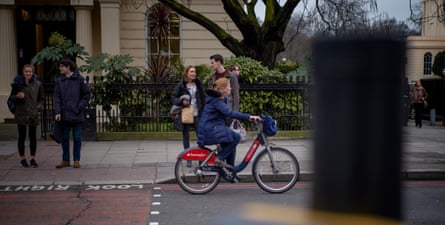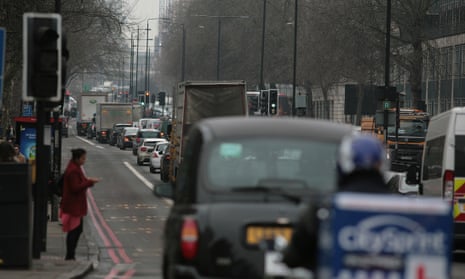Daybreak in the capital and on the pavement opposite Great Portland Street underground station runners cut virtuous paths through a crisp, cold winter’s morning. To one side of them lies Regent’s Park, deep green beneath a perfect frost. On the other roars a source of contamination so severe that the health of these runners might have been better served staying indoors.
Marylebone Road, one of London’s main east-west streets, illustrates with filthy glamour why the city suffers from stubbornly poor air quality – with recent record-breaking pollution levels having caused particular concern.
The road bears three and sometimes four lanes of intermittently fast-moving cars, vans, taxis, lorries, coaches and buses to and from the inner metropolis: past Madame Tussauds, junctions with Baker Street, home of Sherlock Holmes, the 200-year-old St Marylebone Parish Church, the University of Westminster, several imposing hotels and, somewhat ironically, a cluster of medical facilities.
Across the road from Tussauds, right at the pavement’s edge, stands a large, brown, crate-like construction containing what King’s College’s air quality expert Dr Gary Fuller describes as “the foremost urban air pollution research lab in the world”. He believes this monitoring site, set up in 1997 and now a part of the network of the Department for Environment, Food and Rural Affairs, makes Marylebone Road “the most studied road in air pollution terms anywhere”.
This article includes content provided by Facebook. We ask for your permission before anything is loaded, as they may be using cookies and other technologies. To view this content, click 'Allow and continue'.
This internal combustion corridor provides one of London’s starker spectacles of motor pollution. Its diesel-powered vehicles discharge fumes of nitrogen dioxide (NO2) and microscopic soot particles, while further “particulate matter” is produced by the friction of tyres on asphalt and wear on brakes. All become airborne hazards to human lungs throughout the capital, prematurely ending an estimated 9,500 lives a year.
Between 2005 and 2009, the capital saw average NO2 rises of 11% – a period in which the trend was supposed to be towards reaching new, lowered limits. “This was one of the things that was first discovered at Marylebone Road,” Fuller says. “It was like a canary, tweeting away that something was going wrong.”
Around the road is the neighbourhood of Marylebone itself, an irregular grid of fine, primarily residential streets and handsome squares. The two City of Westminster council wards that cover most of the area – stretching south to another notorious pollution hotspot, Oxford Street – contain around 25,000 residents, none of them safe from the effects of a toxic atmosphere.
Westminster City council has made a successful bid for £1m in funds from the London mayor, Sadiq Khan, to set up a low emission neighbourhood encompassing the two wards (one of five LENs across the capital). Also supported by local business organisations, landowners and residents’ groups, it will introduce an array of small policies, some on a trial basis, with the aim of having a large improving impact on air quality that has been the subject of serious scrutiny in recent weeks.

On 23 January, a “very high” London-wide air pollution warning was issued for the first time through a new system brought in by Khan, after a maximum reading for particulates was registered along Marylebone Road and elsewhere. The episode illuminated more variables in London’s air pollution equation: low temperatures and a lack of wind, which meant that pollutants, augmented by the contribution of newly fashionable wood-burning fires, weren’t being dispersed.
According to the mayor, this “shameful” state of affairs meant “everyone, from the most vulnerable to the physically fit, may need to take precautions to protect themselves”.
Trials and errors
The question of which is the most polluted part of London is, in the words of the King’s College research group that gathers pollution data from dozens of monitoring sites, “difficult to answer sensibly”. This is because different sites have different goals, while “pollution hotspots are often quite small and vary depending on the weather and the time of year”.
But Marylebone Road and its surroundings have consistently illustrated issues surrounding London’s most persistent air quality problems and the attempts to solve them.
Its most vexing finding of late is that levels of NO2 are not being brought down nearly fast enough. This is in line with a report by King’s scientists, published last autumn, which found that, since 2010, most monitored roads in London showed an average NO2 decrease of 5% a year, thanks substantially to a clean-up of buses.

According to Fuller, there is “still a long way to go” in combatting NO2 – but the Marylebone Road monitor has also generated some better news over the years. He relates how after diesel standards were tightened from 2008, removing a lot of sulphur from the fuel, the number of dangerous particles in the air there fell 60% within a month or so. “I don’t know of any other fall in urban air pollution that dramatic resulting from a policy,” Fuller says.
It certainly worked better than the “dust suppressant” measures introduced by the then London mayor Boris Johnson in 2011 to “glue” harmful particles to ground along the road, but which the monitoring kit later showed to have been ineffective.
King’s College is to play a part in the LEN scheme, which originated with the Johnson mayoralty and has been expanded under his successor. There are plans for new green spaces, additional charging points for electric vehicles (including dedicated shared ones for residents), and incentives for changes in behaviour.
A policy of fining vehicle owners who leave their engines idling despite being asked to switch them off will operate intensively in the LEN, with “air marshals” serving £80 penalty charge notices. And from 3 April, a 50% surcharge will be levied on visiting diesel cars parking within Marylebone, pushing the hourly rate up to £7.35 per hour.
Cross-party concern
Air quality has become the biggest concern for residents across Conservative-run Westminster over the past two years, overtaking issues such as litter and antisocial behaviour.
Tim Carnegie, who chairs the Marylebone Association, has lived in the area for 16 years and was closely involved in developing the LEN bid. He says the community has come together “to recognise the issue and do something about it”.
A chartered surveyor whose job entails giving companies location advice, Carnegie either walks or cycles to work, and regularly takes his two young daughters to primary school on foot. He notices what he and they are breathing: “You can taste it in Marylebone,” he tweeted of the pollution on the day of Khan’s “very high” alert.
Architect Stephen Quinn, a resident of 20 years who has children aged 11, 13 and 15 and is also a Marylebone Association member, has found his own behaviour changing as his awareness of air quality has grown.
“I’ve got to the point where if I cross Baker Street or Gloucester Place or one of the busier roads when there’s a lot of traffic, I hold my breath. If I’m waiting for the green man so I can cross Marylebone Road, I stand well back from the kerb, which is where the pollution is worst. I tell the kids to hold their breath if they’re walking past a bus exhaust.”
Quinn stresses the importance of educating people about a problem that many still fail to appreciate because it is largely invisible. It is, though, increasingly recognised by business.

Westminster council cabinet member Heather Acton, who was until recently responsible for sustainability and parking – and has taken to wearing an anti-pollution mask when cycling – championed the LEN bid. She says that poor air quality has become “one of a number of environmental concerns when companies are deciding where to locate offices”, and that some have rejected central London as a result.
Significantly, the scheme’s supporters include three of central London’s business improvement districts (BIDs) – partnership bodies formed by businesses to improve local trading conditions – whose domains overlap parts of the LEN. They share its interest in lessening traffic congestion and are facilitating “consolidation” practices, such as the use of the same waste collection supplier, to reduce the number of heavy vehicles on the streets.
Kay Buxton, executive director of the Marble Arch BID, stresses the value of click-and-collect facilities to cut down on deliveries, and of adjustments to kerbside parking regulations that can mitigate the congestion effects of London’s private-hire taxi boom.
Labour mayor Khan has won praise for going further and faster than his Tory predecessor in his efforts to clean up London’s air. But despite being urged by pressure groups Doctors Against Diesel and Clean Air London to ban diesel vehicles outright, he says he lacks the required powers to follow the examples of Paris, Madrid, Mexico City and Athens, which in December all announced their intention to have them removed from their roads by 2025.
Khan has, though, speeded progress towards introducing a central London ultra low emission zone, urged the government to help with a diesel scrappage scheme and a new Clean Air Act, and announced a programme for low-emission bus zones on routes with many schools on them.
One of these skirts the Marylebone LEN, winning praise from Conservative councillor Acton – an indicator that air quality is of cross-party concern as well as uniting employers and environmentalists. The mayor will need to channel all the power of that consensus if Londoners are to breathe easy on Marylebone Road.
Guardian Cities is dedicating a week to investigating one of the worst preventable causes of death around the world: air pollution. Explore our coverage at The Air We Breathe and follow Guardian Cities on Twitter and Facebook to join the discussion

Comments (…)
Sign in or create your Guardian account to join the discussion